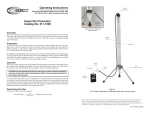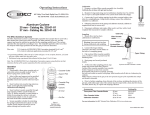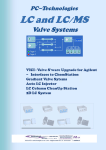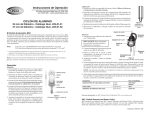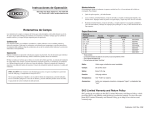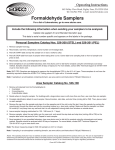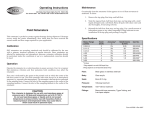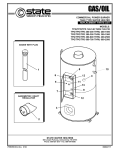Download UMEx 100 Operating Instructions
Transcript
Operating Instructions 863 Valley View Road, Eighty Four, PA 15330 USA Tel: 724-941-9701 Fax: 724-941-1369 e-mail: [email protected] Passive Sampler for Formaldehyde Catalog No. 500-100 Developed in collaboration with the National Institute of Working Life in Umea, Sweden and validated by OSHA, the SKC UME x 100 Formaldehyde Passive Sampler collects formaldehyde in the 5 ppb to 5 ppm range*. The UMEx 100 Passive Sampler contains a tape treated with 2,4-dinitrophenylhydrazine (DNPH). Each sampler incorporates a “blank/correction” section of tape in addition to the sample section of tape. Analysis is by high-performance liquid chromatography (HPLC) for identification of formaldehyde that may be present in the sample. Designed for single use, the SKC UMEx 100 Passive Sampler is packaged in an aluminized pouch for easy sample transport to a laboratory. * If sampling in an atmosphere containing formalin, see www.skcinc.com/instructions/1795.pdf for field study information. Application Notes Because of the UMEx 100 Sampler’s relatively high sampling rate and sensitive analysis, it can be used for 15-minute (STEL) sampling in the ppm range, personal monitoring up to 8 hours, and 24-hour or 7-day static monitoring of contaminants found in indoor environments. Note: Sampling periods between 24 hours and 7 days have not been evaluated. www.skcinc.com Performance Profile Sampling Rate for Formaldehyde: 28.6 ml/min with a relative standard deviation of 18% independent of variations in relative humidity and wind face velocities between .05 and 1.0 m/s (meters per sec) for up to 8 hours or 24 hours 20.4 ml/min average sampling rate for 7-day sampling# See the Passive Sampling Guide at www.skcinc.com for UMEx 100 sampling rates for other aldehydes. Concentration Range: 5 ppb to 5 ppm Detection Principle: Formation of stable DNPH-hydrazone in the presence of formaldehyde* Analysis Method: Desorption of hydrazone and analysis by HPLC with UV detection Lower Detection Limits: 15 minutes: 200 ppb (.24 mg/m3) 8 hours: 5 ppb (.006 mg/m3) 24 hours: 2 ppb (.002 mg/m3) 7 days: 0.2 ppb (.0002 mg/m3)# Shelf-life: 12 mos from date of manufacture at ≤39.2 F (4 C) Storage: Before use: ≤39.2 F (4 C) After use: ≤39.2 F (4 C) and analyze within three weeks Capacity: 29 μg/sample Do not store with food. Accuracy: ± 25%, exceeds OSHA requirements Temperature Effects: No effect on sampling rate between 10 and 30 C Humidity Effects: No effect from 10 to 80% relative humidity (RH). Do not use sampler below 10% RH. Wind Velocity Effects: No effect from 0.05 to 1.0 m/s; good correlation at 0.02 m/s Interferences*: • Highly specific for formaldehyde. Large amounts of carbonyl compounds may reduce the uptake of formaldehyde • Use in ozone levels less than 0.5 ppm Dimensions: 3.4 x 1.1 x .35 in (8.6 x 2.8 x .89 cm) Weight: 0.38 oz (10.9 gm) Slide Cover: Green Sampling periods between 24 hours and 7 days have not been evaluated. * If sampling in an atmosphere containing formalin, see www.skcinc.com/instructions/1795.pdf for field study information. # Sampling Instructions Cautions: • Store at ≤ 39.2 F (4 C) before use. • Do not store with food. • SKC recommends using gloves when handling chemically treated media. • Before sampling, check the expiration date on the pouch label. Do not use after the last day of the month indicated. • UMEx samplers are designed for single use only. Do NOT reuse UMEx samplers. 1. Open the pouch and remove the sampler. Do not discard the pouch as it is used to send sampler to the laboratory. Store the pouch away from potential formaldehyde sources. Note: Included in the pouch is a small length of tape similar to the tape inside the sampler. This tape protects the background of the sampler should any formaldehyde in the atmosphere enter the pouch. Leave the tape inside the pouch at all times and send along with the sample to the laboratory. 2. 3. 4. 5. 6. 7. Enter date and location in the space provided on the back of the sampler. Position the sampler on a worker’s collar for personal sampling or in an appropriate location for area sampling. Slide the sampler cover to the “on” position to begin sampling. Enter the sample start time in the space provided on the back of the sampler. After sampling for the desired time, up to 8 hours, slide the sampler cover to the “off ” position to stop sampling. Enter the sample stop time in the space provided on the back of the sampler. Place the sampler in the original pouch immediately after sampling. Seal the pouch. Send pertinent information and sample to an accredited laboratory for analysis. Use expedited shipping. Analysis Instructions Derivative Preparation Note: Prepared derivative standards are commercially available. 1. 2. 3. 4. 5. 6. la rc ol C pe ta ct iv R ea D iff us i e te pl a Remove the sampler from the pouch and the sliding cover from the sampler. Use forceps (cleaned with acetonitrile) to lift out the reactive tape from each section. Place each in a sealed vial. This provides a sample and a blank/correction. on 1. (s am Sample Preparation lip pl e ) 7. Add 10 ml concentrated hydrochloric acid to 2 grams of 2,4-dinitrophenylhydrazine under stirring. The yellowish crystal mass is dissolved in 200 ml ethanol (95%). Stir for 30 minutes, then cap the flask. Filter to remove undissolved hydrazine hydrochloride. Add 0.8-ml 37% aqueous formaldehyde to form a yellowish precipitate. Filter and wash the crystals with 5-ml cold ethanol and recrystallize twice by adding boiling ethanol (95%). Prepare standard solutions in acetonitrile. Note: The blank/correction section of tape has an indentation for easy identification. 2. The formaldehyde 2,4-dinitrophenylhydrazone is desorbed from both the sample and blank/correction tapes by placing each in its own 4-ml glass vial containing 3.0 ml of acetonitrile and shaking them by hand for one minute. Sample Analysis 1. A 10-μl portion of the solution resulting from Step 2 above is subjected to high-performance liquid chromatographic (HPLC) determination using an octadecylsilane column and a mobile phase consisting of 33% water in methanol ‡. Reactive tape (blank/correction) Body Sliding cover 2. 3. The formaldehyde 2,4-dinitrophenylhydrazone is detected with UV absorption between 230 and 370 nanometers (nm). Tunable UV detectors should use 365 nm for optimum results. Detection limit depends on instrument sensitivity. Quantitative analysis is performed using the synthesized formaldehyde hydrazone as an external standard and then converting results to reflect concentration in formaldehyde. Use the following formula: Concentration μg/ml formaldehyde = Concentration μg/ml hydrazone x 30.03 210.21 Where molecular weight of formaldehyde is 30.03 Where molecular weight of formaldehyde — 2,4-dinitrophenylhydrazone is 210.21 4. 5. Formaldehyde content of the blank/correction tape must always be subtracted from the sample tape when calculating air concentrations. Calculate the results by comparing the standards against the samples. Use the following formulas to calculate: Total mass collected (μg) = Concentration (μg/ml) x Desorption Volume (ml) Volume of air (liters) = Time (minutes) x Sampling rate (28.6 ml/min ¥) 1000 Concentration = Total mass collected (mg) x 1000 (mg/m3) Total volume sampled PPM in air = (24.45/30.03) x mg/m3 ‡ Other conditions may be acceptable. ¥ When calculating results from 7-day sampling, use a sampling rate of 20.4 ml/min. UMEx Passive Samplers UMEx 100* for formaldehyde and other aldehydes UMEx 200* for sulfur dioxide and/or nitrogen dioxide UMEx 400* for amines Accessory Treated Tape, for QC purposes only Catalog No. 500-100 500-200 500-400 P20084 * Limited shelf-life; storage at ≤39.2 F (4 C) required. Do not store with food. Designed for single use only. Do NOT reuse UMEx samplers. References Levin, J.O. and Lindahl, R., “Diffusive Air Sampling of Reactive Compounds - A Review,” Analyst, Vol. 119, Jan. 1994, pp. 79-83 Levin, J., et al, “High-performance Liquid Chromatographic Determination of Formaldehyde in Air in the Ppb and Ppm range Using Diffusive Sampling and Hydrazone Formation, Sweden Environ. Technology Letter 9, 1988, pp. 1423-1430 OSHA Method 1007 Formaldehyde (Diffusive Samplers), May 2005 Levin, J. O., Lindahl, R., and Andersson, K., “A Passive Sampler for Formaldehyde in Air Using 2,4-Dinitrophenylhydrazine-coated Glass Fiber Filters,” Environmental Science and Technology, Vol. 20, No. 12, 1986, pp. 1273-1276 Notice: This operating instruction may not address all safety concerns (if any) associated with this product and its use. The user is responsible for determining and following the appropriate safety and health practices and regulatory limitations (if any) before using the product. The information contained in this document should not be construed as legal advice, opinion, or as a final authority on legal or regulatory procedures. Form # 3760 Rev 1003





